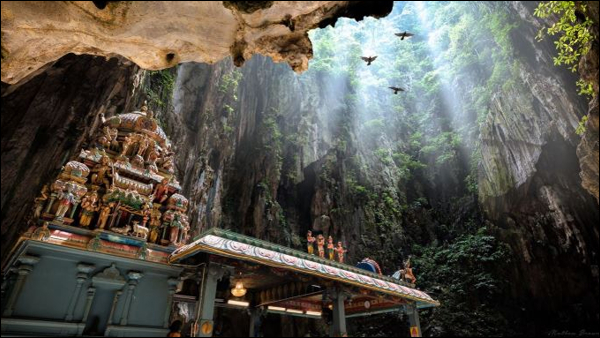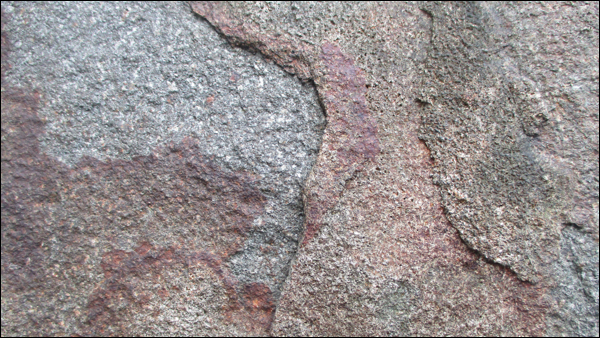This urban EarthCache guides you to a sandstone boulder commemorating the launch of the Kuala Lumpur Convention Centre development by Tun Dr. Mahathir Mohamad, fourth and seventh Prime Minister of Malaysia (1981 to 2003, 2018 to 2020). Exhumed during the excavation works for the Kuala Lumpur Convention Centre, this boulder provides a fine example of spheroidal weathering, a natural phenomena rarely observed in a modern urban environment!
Type of Earthcache: Denudation, exfoliation, spheroidal weathering.
Geology of the Kuala Lumpur area
The underlying geological conditions of Kuala Lumpur can be distinctly demarcated to two main formations namely Kuala Lumpur Limestone and Kenny Hill Formation.
The Kuala Lumpur basin is dominated by Kuala Lumpur Limestone, estimated to reach a maximum depth of about 1,850m. Kuala Lumpur Limestone usually occurs at shallow depths of a few metres to less than 25 metres except in areas covered by the thick Kenny Hill Formation where Kuala Lumpur Limestone is only encountered at a depth of 200 metres, i.e. the site of the Petronas Twin Towers1.
Kuala Lumpur Limestone is Upper Silurian marble, finely crystalline grey to cream, thickly bedded, variably dolomitic rock. Banded marble, saccharoidal dolomite, and pure calcitic limestone also occurs2. It is known for posing great uncertainties and difficulties in foundation construction.
Kenny Hill Formation rock is a typical sedimentary rock consisting of typical interbedded sandstone, siltstone and shale of Upper Silurian-Devonian age (443.8 to 358.9 million years). This rock formation has been metamorphosed into a low grade metamorphism; sandstone been metamorphosed to quartzite, while shale became phyllite3, and is almost entirely devoid of any tectonic features inicative of intense compresion or stretching4. The Kenny Hill Formation which roughly stretches from KLCC to Bukit Bintang, is underlain by graphitic schist locally refered to as Hawthornden Schist. The entire sequence rests atop the Kuala Lumpur Limestone much like the eye on a fried egg.
Besides pinnacled bedrock profiles, sinkholes, overhangs, etc., the contact zones between the limestone and other rock formations such as granite and the Kenny Hill Formation are of great interest to engineers and geologists alike. The contact zones often exhibit deep solution channels or troughs due to differential and preferential erosion/solution along the limestone side of the contact zone5. The local geology was the reason why the location for the Petronas Twin Towers and Kuala Lumpur Convention Centre (KLCC) had to be shifted a good 60 metres away from their proposed location, to the more predictable Kenny Hill formation, rather than being built on the riskier karst6. This is due to the geological fractures, sinkholes, cavities and karst features forming an irregular surface within the limestone bedrock, described as the worst terrain in the world7. Knowing that the terrain had to support not one, but two towers of 300,000 metric tonnes, rock strength alone, ranging from 50MPa for parts of the decaying Kuala Lumpur Limestone, down from 230 MPa for the Kenny Hills Formation rock, would be enough justify a shift.
In general, Kuala Lumpur Limestone could only be observed when exposed at excavation sites for larger building projects, however, massive outcrops of Kuala Lumpur Limestone can be witnessed about 10km north from here. These outcrops are collectively known as the Batu Caves, famous for its impressive Hindu cave temples set in karst and internationally recognised as one of the important sites during Thaipusam (a Hindu festival).

The famous Batu Caves sited in Kuala Lumpur Limestone.
Sandstone
The boulder before you is sandstone originating from the Kenny Hill Formation. Sandstones are made of sand grains that have been cemented together. Like sandpaper, sandstones usually have a rough, granular texture, but to really identify a sandstone you have to peer closely at its surface and look for individual sand grains ranging in diameter from 2 mm all the way down to only 0.06 mm. Cement is what binds the siliciclastic framework grains together.
Cement is a secondary mineral that forms after deposition and during burial of the sandstone. Calcite cement is the most common carbonate cement. Calcite cement is an assortment of smaller calcite crystals. The cement adheres itself to the framework grains, this adhesion is what causes the framework grains to be adhered together. Other minerals that can act as cements include: hematite, limonite, feldspars, anhydrite, gypsum, barite, clay minerals, and zeolite minerals.

Mahathir's Corestone at the Kuala Lumpur Convention Centre (KLCC).
(Source: Barnyard Dawg, 2019)
Exfoliation
The spheroidal weathering process most obvious to this boulder, is exfoliation. Exfoliation is a form of mechanical weathering in which curved slabs of rock detach and slough off from the rock below. It is thought to be the result of "unloading", whereby overlying rock is lost through erosion or excavation. Removal of overburden releases the pressure, causing previously-confined rock below to rebound, fracturing in the process. Layers of rock are then shed as sheets (instead of grain by grain), eventually leaving a spherical core or corestone (also woolsack) behind. This spalling process is often referred to as onion peeling.
The basis of the rebound-theory is that erosion of overburden and exhumation of deeply buried rock to the ground surface allows previously compressed rock to expand radially, creating tensile stress and fracturing the rock in layers parallel to the ground surface. The description of this mechanism has led to alternate terms for exfoliation joints, including pressure release or offloading joints.
Though the logic of this theory is appealing, inconsistencies with field and laboratory observations suggest that it may be incomplete for the following reasons; Exfoliation joints can be found in rocks that have never been deeply buried. Laboratory studies show that simple compression and relaxation of rock samples under realistic conditions does not cause fracturing. Exfoliation joints are most commonly found in regions of surface-parallel compressive stress, whereas this theory calls for them to occur in zones of extension.
One possible extension of this theory to match with the compressive stress theory is as follows: The exhumation of deeply buried rocks relieves vertical stress, but horizontal stresses can remain in a competent rock mass since the medium is laterally confined. Horizontal stresses become aligned with the current ground surface as the vertical stress drops to zero at this boundary. Thus large surface-parallel compressive stresses can be generated through exhumation that may lead to tensile rock fracture as described below.
Another viable theory is "thermoelastic strain". Rock expands upon heating and contracts upon cooling and different rock-forming minerals have variable rates of thermal expansion / contraction. Daily rock surface temperature variations can be quite large, and many have suggested that stresses created during heating cause the near-surface zone of rock to expand and detach in thin slabs8. Large diurnal or fire-induced temperature fluctuations have been observed to create thin lamination and flaking at the surface of rocks, sometimes labeled exfoliation. However, since diurnal temperature fluctuations only reach a few centimeters depth in rock (due to rock's low thermal conductivity), this theory alone cannot account for the observed depth of exfoliation jointing that may reach 100 meters.
A third theory refers to "chemical weathering". Mineral weathering by penetrating water can cause flaking of thin shells of rock since the volume of some minerals increases upon hydration. However, not all mineral hydration results in increased volume, while field observations of exfoliation joints show that the joint surfaces have not experienced significant chemical alteration, so this theory can be rejected as an explanation for the origin of large-scale, deeper exfoliation joints.
And finally, "compressive stress and extensional fracture". Large compressive tectonic stresses parallel to the land (or a free) surface can create tensile mode fractures in rock, where the direction of fracture propagation is parallel to the greatest principle compressive stress and the direction of fracture opening is perpendicular to the free surface. This type of fracturing has been observed in the laboratory since at least 1900 (in both uniaxial and biaxial unconfined compressive loading9.
Tensile cracks can form in a compressive stress field due to the influence of pervasive microcracks in the rock lattice and extension of so-called wing cracks from near the tips of preferentially oriented microcracks, which then curve and align with the direction of the principle compressive stress. Fractures formed in this way are sometimes called axial cleavage, longitudinal splitting, or extensional fractures, and are commonly observed in the laboratory during uniaxial compression tests. High horizontal or surface-parallel compressive stress can result from regional tectonic or topographic stresses, or by erosion or excavation of overburden. With consideration of the field evidence and observations of occurrence, fracture mode, and secondary forms, high surface-parallel compressive stresses and extensional fracturing (axial cleavage) seems to be the most plausible theory explaining the formation of exfoliation joints.

Detail of Mahathir's Corestone at KLCC.
(Source: Barnyard Dawg, 2019)
How to claim this EarthCache?
Send me the following;
1. The text "GC86GD0 Mahathir's Corestone" on the first line.
2. The answers to the following questions;
- Look carefully at the boulder, how many layers can you identify?
- How do you recognise the exfoliating layer(s) on this boulder?
- Where is the exfoliation process the strongest? Explain why.
- Can you tell where and why the layers will start to peel next?
- Which forms of mechanical or chemical weathering mentioned apply?
- How thick are the exfoliating layer(s), an estimate will do.
- Why is this considered a corestone and how do you see it evolve?
3. Provide a photo of yourself or a personal item to prove you have visited the site.*
References
1 Azam et. al., 1996. 2 Gobbett & Hutchison, 1973. 3 Mohamed et al., 2004. B.K. Tan., 2006. 4 B.K. Tan & E.B. Yeap, Structure of the Kenny Hill Formation, Geological Society of Malaysia, Bulletin 8, 12/1977, p128. 5 Tan Boon Kong, Engineering geology in Malaysia, Geological Society of Malaysia, vol. 64, 12/2017, pp. 65 – 79. 6 Azam et al. 1996. Tan, 1996. 7 Gue and Tan 2001. Xeidakis et al. 2004. Zabidi et al. 2006. Samy et al. 2010b. 8 Wolters, 1969. 9 Gramberg, 1989.
* Effective immediately from 10 June 2019, photo requirements are permitted on EarthCaches. This task is not optional, it is an addition to existing logging tasks! Logs that do not meet all requirements posed will no longer be accepted.
For additional information, visit; Geosociety.org, Geocaching.com Help Center and Geocaching.com Forum.
Finding the answers to an EarthCache can often be challenging, and many people tend to shy away from these caches because of this. However, it is my opinion that geocaching is also meant to be a fun family experience that simply aims to introduce interesting and unique locations such as this one. Flexibility on logging requirements, however, can only be applied if it can be established that you have actually taken the time to visit the site. For this reason, a proper log describing your adventure accompanied by a good number of photos would be much appreciated.

Join us at Geocaching Malaysia